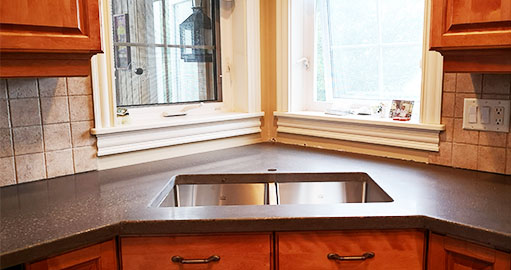
How to choose a sink
Choosing a sink to go with your new countertops can be a harder part of the process than you might expect. It is often an after-thought or a last-minute decision, but it shouldn’t be – for a couple of reasons:
- Your sink choice may dictate the way your cabinets are built, or may necessitate modifications to your existing cabinets. The more information you can give your cabinetmakers or contractor upfront, the smoother the process will go – and the less likely you are to incur delays (and extra costs).
- Unless you are working with a laminate countertop that can easily be cut on site, your countertop fabricators are going to need to know the precise sink shape and dimensions before they begin fabrication. In our case, with concrete, we build the sink cut-out right into the mould, so we require the sink before we can pour your countertops.
- Remember, too, that the sink you want (or need) may not be available for off-the-shelf purchase at the time that you go looking for it, and it can take some time to bring in special orders. If you don’t have your sink in hand at the time of templating, you may delay the fabrication and installation of your countertops, which can be frustrating for both you and your countertop fabricators.
When it comes to selecting your sink, there are two basic considerations (material and colour aside): the style of sink, and the size of the sink. The style – usually a choice between top-mount, undermount, farmhouse or vessel – is a question of design and personal preference. The size of your sink, however, is very much determined by the size of your cabinets and the structural requirements of your countertops.
Size: At the most basic level, your sink must be SMALLER than your sink cabinet. You need to make sure that there is enough room in the interior of your cabinet for the sink to sit and be secured. There are three dimensions that you need to pay attention to.
- Left to right: Sink specifications will generally include a minimum cabinet size. For example, a 33” sink (referring to the measurement from left to right from the outer edges of the sink lip) might specify a minimum cabinet size of 36”. (Not sure what size sink cabinet you need? 36” wide is a good, standard option.) Note that the cabinet size specified is referring to outside measurements (from outside edge to outside edge of the cabinet), so the actual width of the open space where the sink has to fit will be smaller than this. Sink manufacturers tend to cut it tight when specifying minimum cabinet size, so it is a good idea to check with your installers about their specific requirements for sink sizes before purchasing your sink.
- Front to back: Verify the size of your sink from front to back to ensure that it is compatible with the depth of your cabinets and countertops. For top-mount and undermount sinks, you need a certain width of countertop material in front of, and behind, your sink cut-out to satisfy structural and functional considerations. Farmhouse sinks and vessel sinks need to leave enough room behind the sink to place faucet holes in the countertop without getting too close to the back edge. Whatever kind of sink you choose, remember to allow room behind the sink for faucets and accessories, your backsplash (if applicable) and window sills that might stick out and limit how far back your faucet can go.
- Basin depth: The depth of your sink basin has less to do with countertop requirements or cabinet size, and more to do with sink capacity, ergonomics and water consumption. How much water will it take to fill up your sink? How far do you want to reach down when washing? How big are your pots and pans? You will need to ensure that the plumbing for your sink is designed accordingly. If you are replacing an existing sink with a deeper or shallower basin, you may need to have the height of the plumbing adjusted to align with your sink drain.
When it comes to concrete, we have two main considerations:
- We need to ensure that the concrete around the cut-out is wide enough on all sides to be structurally sound (wide enough at the back to accommodate faucet holes, if required, and wide enough front and back to minimize the likelihood of cracking during transportation and installation); and
- We need enough space between the sink walls and the inside edges of the cabinet to properly secure the sink in place. For undermount sinks, in particular, we use a combination of silicone and compression clips, and need room to get our hands and tools into the space between the sink and the cabinet to secure the clips. The minimum cabinet size specifications do not always allow for this.
Every style of sink has its own specific installation requirements, which are important to understand as you choose your sink. Whether you're just starting your kitchen project, trying to figure out what kind of sink you want, or in the process of shopping for a specific sink, check out our Guide to Choosing your Sink on the Resources page of our website to learn more about general considerations for different styles of sink, as well as our specific requirements. If you’ve still got questions, we’d be happy to help!






